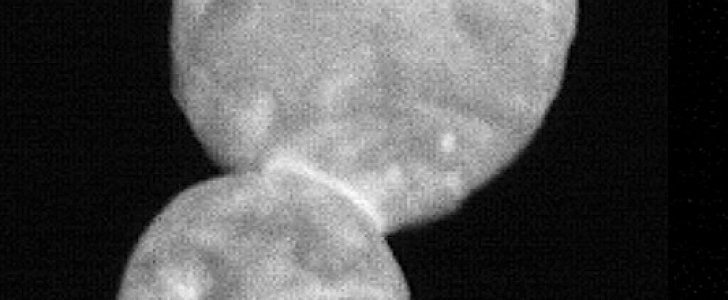It was an exciting start of the year for NASA, as one of its spacecraft made a historic flyby of the most distant object ever explored on January 1.
The moment marked only the start of a year that will most likely change the face of space exploration for our planet. It was, if you like, the perfect way to kick it off the next few months, by allowing humans to see something they've never seen before.
New Horizons, a spaceship launched in 2006 to explore the outskirts of our solar system, met Ultima Thule, a rock 30 kilometers (19 miles) in diameter, at a distance of 6.5 billion kilometers from Earth (4.03 billion miles).
NASA scientists have called the snowman-like object “unlike anything we've seen before.” The image you see above was taken from a distance of 17,000 miles (27,000 km) and shows Ultima Thule as a conjoined celestial body, comprised of two connected spheres.
Officially, this formation is called contact binary. The bigger section is 12 miles (19 km) across, while the smaller one 9 miles (14 km) across.
NASA speculates the two have come together at the very beginning of solar system formation (as early as 99 percent of the way back, says NASA), at speeds no greater than that of an average fender-bender.
"New Horizons is like a time machine, taking us back to the birth of the solar system. We are seeing a physical representation of the beginning of planetary formation, frozen in time," said in a statement Jeff Moore, New Horizons Geology and Geophysics team lead.
"Studying Ultima Thule is helping us understand how planets form — both those in our own solar system and those orbiting other stars in our galaxy."
More data sent by New Horizons is set to flood Earth in the coming months, helping Earthlings better understand how the planets in our solar system came to be.
New Horizons, a spaceship launched in 2006 to explore the outskirts of our solar system, met Ultima Thule, a rock 30 kilometers (19 miles) in diameter, at a distance of 6.5 billion kilometers from Earth (4.03 billion miles).
NASA scientists have called the snowman-like object “unlike anything we've seen before.” The image you see above was taken from a distance of 17,000 miles (27,000 km) and shows Ultima Thule as a conjoined celestial body, comprised of two connected spheres.
Officially, this formation is called contact binary. The bigger section is 12 miles (19 km) across, while the smaller one 9 miles (14 km) across.
NASA speculates the two have come together at the very beginning of solar system formation (as early as 99 percent of the way back, says NASA), at speeds no greater than that of an average fender-bender.
"New Horizons is like a time machine, taking us back to the birth of the solar system. We are seeing a physical representation of the beginning of planetary formation, frozen in time," said in a statement Jeff Moore, New Horizons Geology and Geophysics team lead.
"Studying Ultima Thule is helping us understand how planets form — both those in our own solar system and those orbiting other stars in our galaxy."
More data sent by New Horizons is set to flood Earth in the coming months, helping Earthlings better understand how the planets in our solar system came to be.

